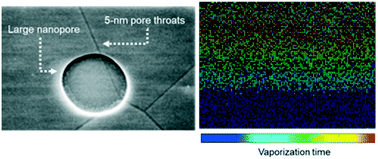Natural gas vaporization in a nanoscale throat connected model of shale: multi-scale, multi-component and multi-phase†
Abstract
Production of hydrocarbons from shale is a complex process that necessitates the extraction of multi-component hydrocarbons trapped in multi-scale nanopores. While advances in nanofluidics have allowed researchers to probe thermodynamics and transport in single, discrete nanochannels, these studies present a highly simplified version of shale reservoirs with homogeneous pore structures and/or single-component fluid compositions. In this study, we develop and apply a 30 000-pore nanomodel that captures the inherent heterogeneity in reservoir pore sizes (100 nm pores gated by 5 nm-pores) to study vaporization of a representative natural gas hydrocarbon mixture. The nanomodel matches major North American formations in the volumetric and number contributions of the pore sizes, porosity (10.5%), and ultra-low permeability (44 nD). Combined experimental and analytical results show 3000× slower vaporization owing to the nanoscale throat bottlenecks. At low temperatures, mixture effects reduce rates further with stochastic vaporization of light components in large pores dominating. Collectively this approach captures the coupled complexity of multicomponent, multiphase fluids in multiscale geometries that is inherent to this resource.

- This article is part of the themed collection: Lab on a Chip Recent HOT Articles


 Please wait while we load your content...
Please wait while we load your content...